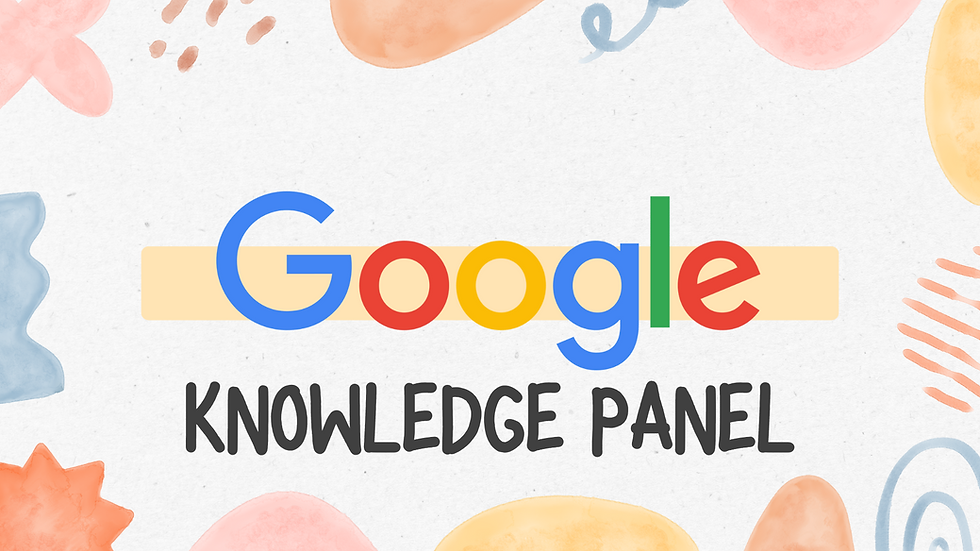Google Knowledge Graph: The Ultimate Guide for Businesses and Marketers
- Muhammed Arif

- Nov 1, 2024
- 3 min read
In today’s digital world, information is everything. Whether you’re a business, a marketer, or a content creator, harnessing the power of the Google Knowledge Graph can set you miles ahead of competitors. Understanding Google’s Knowledge Graph helps you strategically position your brand, deliver relevant information faster, and establish credibility within search engine results. Let’s dive deep into what the Google Knowledge Graph is, how it works, and how you can leverage it to elevate your online presence.

What is Google Knowledge Graph?
Launched in 2012, the Google Knowledge Graph is a system that organizes information about entities like people, places, organizations, and events, displaying them in a structured way in search results. Essentially, it’s Google’s way of connecting data points and displaying answers directly on the search page. Imagine typing “Albert Einstein” into Google and immediately seeing a box that outlines essential information: a photo, biography, notable works, and related topics. This box, known as a Knowledge Panel, is Google’s way of making information easily accessible without requiring a user to visit multiple sites.
The Knowledge Graph goes beyond just showing what’s popular or relevant. It’s powered by an intelligent data network that understands relationships between entities, so it can make smart connections between topics. For example, if you search for “Marie Curie,” Google might also show related scientists, scientific discoveries, or periods in history, enriching the search experience.
Why the Knowledge Graph Matters for Your Brand
The Knowledge Graph is not just an answer box; it’s a powerful tool that can drive traffic, establish authority, and boost visibility for your brand. Here’s how:
Enhanced Visibility: Being included in the Knowledge Panel can skyrocket your brand’s exposure, ensuring that potential customers see it directly when searching for relevant terms.
Instant Credibility: A Knowledge Panel positions your brand as a verified, authoritative source of information, which can foster trust with searchers who see your presence in the graph.
Increased Traffic: With the Knowledge Graph’s powerful reach, users may click on your links without needing a traditional SEO push, helping you capture high-intent traffic effortlessly.
Brand Differentiation: Appearing in the Knowledge Graph distinguishes your brand, especially if your competitors haven’t achieved this yet.
Engagement and Click-through Rates (CTR): Knowledge Panels tend to have high engagement, as they often feature directly clickable information that can take users to your website or social media profiles.
How to Measure the Success of Your Knowledge Graph Strategy
Tracking the effectiveness of your Knowledge Graph strategy is essential to see whether your efforts are paying off. Here are some ways to measure success:
Google Search Console: Analyze queries and click-through rates for branded searches. If you see an uptick, this could mean your Knowledge Panel is driving more clicks.
Brand Awareness Metrics: Tools like SEMrush or Ahrefs can track your brand’s visibility and reach in search engines, showing you if your Knowledge Graph presence is boosting your brand awareness.
Traffic Analysis: Monitor your website analytics to see if there’s an increase in organic traffic specifically from Knowledge Panel clicks.
The Future of Google Knowledge Graph: Trends to Watch
Voice Search and Virtual Assistants: As Google integrates more with virtual assistants like Google Assistant, expect Knowledge Graph information to become even more prominent in spoken responses.
AI-Enhanced Results: Google’s recent AI advances mean it’s getting better at understanding nuances in search queries. Future Knowledge Graph updates may bring in more personalized information or predictive search suggestions.
Increased Use of Visuals: Expect to see more multimedia elements—images, videos, and infographics—in Knowledge Panels as Google pushes toward a more engaging user experience.
Final Thoughts
Mastering the Google Knowledge Graph can place your brand squarely in front of your target audience, establish authority, and increase organic traffic. The Knowledge Graph isn’t just for household names or major companies; with the right strategies, smaller brands and influencers can also achieve visibility in these panels. By investing time in structured data, online consistency, and social proof, you’re setting up your brand for success in an increasingly competitive online landscape.
If you are ready to optimize your brand's digital presence with Google's Knowledge Graph, start small. Let us create a great knowledge panel for you, whether personal or for your brand.
